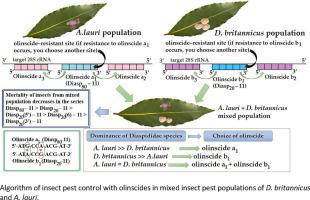当前位置:
X-MOL 学术
›
Pestic. Biochem. Phys.
›
论文详情
Our official English website, www.x-mol.net, welcomes your feedback! (Note: you will need to create a separate account there.)
Mixed insect pest populations of Diaspididae species under control of oligonucleotide insecticides: 3′-end nucleotide matters
Pesticide Biochemistry and Physiology ( IF 4.7 ) Pub Date : 2024-02-22 , DOI: 10.1016/j.pestbp.2024.105838 Nikita V. Gal'chinsky , Ekaterina V. Yatskova , Ilya A. Novikov , Alexander K. Sharmagiy , Yuri V. Plugatar , Vladimir V. Oberemok
Pesticide Biochemistry and Physiology ( IF 4.7 ) Pub Date : 2024-02-22 , DOI: 10.1016/j.pestbp.2024.105838 Nikita V. Gal'chinsky , Ekaterina V. Yatskova , Ilya A. Novikov , Alexander K. Sharmagiy , Yuri V. Plugatar , Vladimir V. Oberemok

|
Diaspididae are one of the most serious small herbivorous insects with piercing–sucking mouth parts and are major economic pests as they attack and destroy perennial ornamentals and food crops. Chemical control is the primary management approach for armored scale infestation. However, chemical insecticides do not possess selectivity in action and not always effective enough for the control of armored scale insects. Our previous work showed that green oligonucleotide insecticides (olinscides) are highly effective against armored and soft scale insects. Moreover, olinscides possess affordability, selectivity in action, fast biodegradability, and a low carbon footprint. Insect pest populations undergo microevolution and olinscides should take into account the problem of insecticide resistance. Using sequencing results, it was found that in the mixed populations of insect pests Newstead and Bouche, predominates the population of Individuals of comprised for 80% of individuals with the sequence 3′-ATC-GTT-GGC-AT-5′ in the 28S rRNA site, and 20% of the population comprised individuals with the sequence 3′-ATC-GTC-GGT-AT-5′. We created olinscides Diasp–11 (5′-ATG-CCA-ACG-AT-3′) and Diasp–11 (5′-ATA-CCG-ACG-AT-3′) with perfect complementarity to each of the sequences. Mortality of insects on the 14th day comprised 98.19 ± 3.12% in Diasp–11 group, 64.66 ± 0.67% in Diasp–11 group ( < 0.05), and 3.77 ± 0.94% in the control group. Results indicate that for maximum insecticidal effect it is necessary to use an oligonucleotide insecticide that corresponds to the dominant species. Mortality in Diasp–11 group was accompanied with significant decrease in target 28S rRNA concentration and was 8.44 ± 0.14 and 1.72 ± 0.36 times lower in comparison with control ( < 0.05) on the 10th and 14th days, respectively. We decided to make single nucleotide substitutions in Diasp–11 olinscide to understand which nucleotide will play the most important role in insecticidal effect. We created three sequences with single nucleotide transversion substitutions at the 5′-end – Diasp(5′)-11 (A to T), 3′-end – Diasp(3′)-11 (T to A), and in the middle of the sequence – Diasp(6)-11 (6th nitrogenous base of the sequence; G to C), respectively. As a result, mortality of mixed population of the field experiment decreased and comprised 53.89 ± 7.25% in Diasp(5′)-11 group, 40.68 ± 4.33% in Diasp(6)-11 group, 35.74 ± 5.51% in Diasp(3′)-11 group, and 3.77 ± 0.94% in the control group on the 14th day. Thus, complementarity of the 3′-end nucleotide to target 28S rRNA was the most important for pronounced insecticidal effect (significance of complementarity of nucleotides for insecticidal effect: 5′ nt < 6 nt < 3′ nt). As was found in our previous research works, the most important rule to obtain maximum insecticidal effect is complete complementarity to the target rRNA sequence and maximum coverage of target sequence in insect pest populations. However, in this article we also show that the complementarity of 3′-end is a second important factor for insecticidal potential of olinscides. Also in this article we propose 2-step DNA containment mechanism of action of olinscides, recruiting RNase H. The data obtained indicate the selectivity of olinscides and at the same time provide a simple and flexible platform for the creation of effective plant protection products, based on antisense DNA oligonucleotides.
中文翻译:

寡核苷酸杀虫剂控制下的双翅目混合害虫种群:3′端核苷酸物质
Diaspididae 是最严重的小型草食性昆虫之一,具有刺吸式口器,是主要的经济害虫,因为它们攻击和破坏多年生观赏植物和粮食作物。化学控制是装甲规模侵扰的主要管理方法。然而,化学杀虫剂不具有作用选择性,对于防治甲壳虫并不总是足够有效。我们之前的工作表明,绿色寡核苷酸杀虫剂(olinscides)对甲壳虫和软介壳虫非常有效。此外,杀虫剂具有经济性、作用选择性、快速生物降解性和低碳足迹。害虫种群发生微进化,杀虫剂应考虑杀虫剂抗性问题。利用测序结果发现,在害虫Newstead和Bouche的混合种群中,28S中80%的个体中含有序列3'-ATC-GTT-GGC-AT-5'的个体占主导地位。 rRNA 位点,20% 的群体包含序列为 3'-ATC-GTC-GGT-AT-5' 的个体。我们创建了与每个序列具有完美互补性的 olinscides Diasp–11 (5'-ATG-CCA-ACG-AT-3') 和 Diasp–11 (5'-ATA-CCG-ACG-AT-3')。第14天昆虫死亡率:Diasp-11组为98.19±3.12%,Diasp-11组为64.66±0.67%(<0.05),对照组为3.77±0.94%。结果表明,为了获得最大的杀虫效果,有必要使用与优势物种相对应的寡核苷酸杀虫剂。 Diasp-11组的死亡率伴随着目标28S rRNA浓度的显着降低,在第10天和第14天分别比对照组低8.44±0.14和1.72±0.36倍(<0.05)。我们决定在 Diasp-11 杀虫剂中进行单核苷酸替换,以了解哪种核苷酸在杀虫效果中发挥最重要的作用。我们创建了三个在 5' 端具有单核苷酸颠换取代的序列 – Diasp(5')-11(A 到 T)、3' 端 – Diasp(3')-11(T 到 A),以及序列的中间 – 分别为 Diasp(6)-11(序列的第 6 个含氮碱基;G 到 C)。结果,田间实验混合种群死亡率下降,Diasp(5′)-11组死亡率为53.89±7.25%,Diasp(6)-11组死亡率为40.68±4.33%,Diasp(3)组死亡率为35.74±5.51%。 ′)-11组,第14天对照组为3.77±0.94%。因此,3'端核苷酸与靶28S rRNA的互补性对于显着的杀虫效果是最重要的(核苷酸互补性对杀虫效果的意义:5'nt < 6 nt < 3'nt)。我们在前期的研究工作中发现,获得最大杀虫效果的最重要规则是与目标rRNA序列完全互补以及目标序列在害虫种群中的最大覆盖度。然而,在这篇文章中,我们还表明,3′端的互补性是杀虫剂杀虫潜力的第二个重要因素。另外,在本文中,我们提出了 olinscides 的两步 DNA 遏制机制,招募 RNase H。获得的数据表明了 olinscides 的选择性,同时为创建有效的植物保护产品提供了一个简单而灵活的平台,基于关于反义DNA寡核苷酸。
更新日期:2024-02-22
中文翻译:

寡核苷酸杀虫剂控制下的双翅目混合害虫种群:3′端核苷酸物质
Diaspididae 是最严重的小型草食性昆虫之一,具有刺吸式口器,是主要的经济害虫,因为它们攻击和破坏多年生观赏植物和粮食作物。化学控制是装甲规模侵扰的主要管理方法。然而,化学杀虫剂不具有作用选择性,对于防治甲壳虫并不总是足够有效。我们之前的工作表明,绿色寡核苷酸杀虫剂(olinscides)对甲壳虫和软介壳虫非常有效。此外,杀虫剂具有经济性、作用选择性、快速生物降解性和低碳足迹。害虫种群发生微进化,杀虫剂应考虑杀虫剂抗性问题。利用测序结果发现,在害虫Newstead和Bouche的混合种群中,28S中80%的个体中含有序列3'-ATC-GTT-GGC-AT-5'的个体占主导地位。 rRNA 位点,20% 的群体包含序列为 3'-ATC-GTC-GGT-AT-5' 的个体。我们创建了与每个序列具有完美互补性的 olinscides Diasp–11 (5'-ATG-CCA-ACG-AT-3') 和 Diasp–11 (5'-ATA-CCG-ACG-AT-3')。第14天昆虫死亡率:Diasp-11组为98.19±3.12%,Diasp-11组为64.66±0.67%(<0.05),对照组为3.77±0.94%。结果表明,为了获得最大的杀虫效果,有必要使用与优势物种相对应的寡核苷酸杀虫剂。 Diasp-11组的死亡率伴随着目标28S rRNA浓度的显着降低,在第10天和第14天分别比对照组低8.44±0.14和1.72±0.36倍(<0.05)。我们决定在 Diasp-11 杀虫剂中进行单核苷酸替换,以了解哪种核苷酸在杀虫效果中发挥最重要的作用。我们创建了三个在 5' 端具有单核苷酸颠换取代的序列 – Diasp(5')-11(A 到 T)、3' 端 – Diasp(3')-11(T 到 A),以及序列的中间 – 分别为 Diasp(6)-11(序列的第 6 个含氮碱基;G 到 C)。结果,田间实验混合种群死亡率下降,Diasp(5′)-11组死亡率为53.89±7.25%,Diasp(6)-11组死亡率为40.68±4.33%,Diasp(3)组死亡率为35.74±5.51%。 ′)-11组,第14天对照组为3.77±0.94%。因此,3'端核苷酸与靶28S rRNA的互补性对于显着的杀虫效果是最重要的(核苷酸互补性对杀虫效果的意义:5'nt < 6 nt < 3'nt)。我们在前期的研究工作中发现,获得最大杀虫效果的最重要规则是与目标rRNA序列完全互补以及目标序列在害虫种群中的最大覆盖度。然而,在这篇文章中,我们还表明,3′端的互补性是杀虫剂杀虫潜力的第二个重要因素。另外,在本文中,我们提出了 olinscides 的两步 DNA 遏制机制,招募 RNase H。获得的数据表明了 olinscides 的选择性,同时为创建有效的植物保护产品提供了一个简单而灵活的平台,基于关于反义DNA寡核苷酸。



























 京公网安备 11010802027423号
京公网安备 11010802027423号